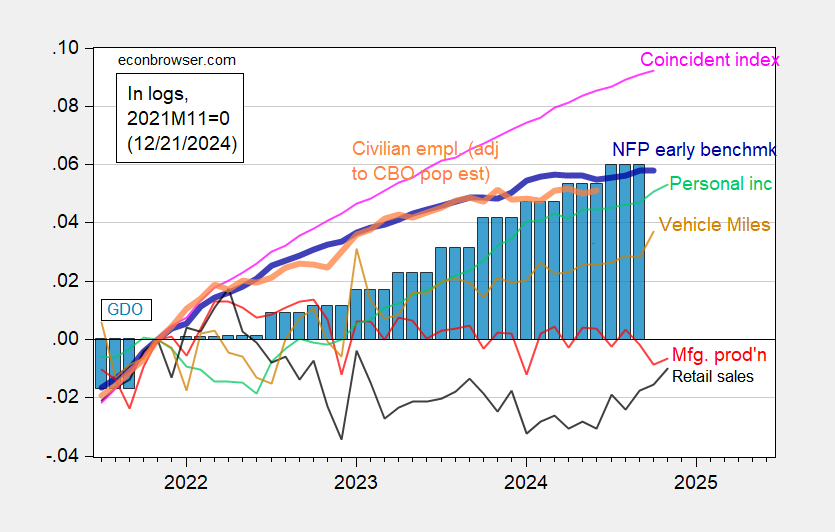NBER BCDC indicators discussed here. Alternative below.
Figure 1: Implied nonfarm Payroll early benchmark (NFP) (bold blue), civilian employment adjusted using CBO immigration estimates (orange), manufacturing production (red), personal income excluding current transfers in Ch.2017$ (bold green), manufacturing and trade sales in Ch.2017$ (black), consumption in Ch.2017$ (light blue), and monthly GDP in Ch.2017$ (pink), GDO (blue bars), all log normalized to 2021M11=0. Source: Philadelphia Fed, Federal Reserve via FRED, BEA 2024Q3 third release, S&P Global Market Insights (nee Macroeconomic Advisers, IHS Markit) (12/2/2024 release), and author’s calculations.
Early benchmark and manufacturing suggest a slowdown. Other indicators do not.

California is a real-world example and repudiation of all the GOP/Fox News/Hoover Institution talking points – Surprise! California’s 40 Qs of Rising Minimum Wage & Fast Food Industry Growth (Beating USA) – https://ritholtz.com/2024/12/california-outpacesd-usa/
Also California is leading the nation on moving to zero-emission vehicles –
https://ww2.arb.ca.gov/news/california-moves-accelerate-100-new-zero-emission-vehicle-sales-2035
Finally – as we move into the next four years of “mass deportations” – please note “Net International Migration Drives Highest U.S. Population Growth in Decades” – also note that documented immigrants pay into Social Security but unless they become citizens they do not collect – which is one reason – I think all this GOP rhetoric of deportations is about oppressing workers – https://www.census.gov/newsroom/press-releases/2024/population-estimates-international-migration.html?utm_campaign=20241219pios1
The idea that increasing minimum wages would cost jobs in any substantial way always seemed completely disassociated from reality. The wages cost is not that big a part of the overall cost so even a say 20% increase in wage costs, would not increase final product cots by much. Soo suggestion that cost increases would drive away customers seem disconnected from the math. On the other hand the minimum wage workers would seem to be a good part of the customer base for fast food – and giving the customers more disposable income should be good for business. No big surprise that the overall outcome as measured suggests that this latter effect beat any potential negatives from marginal cost increases.